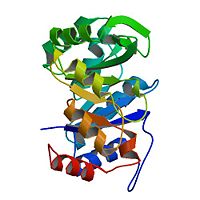Kemp eliminase
From Proteopedia
Alexander Berchansky (Talk | contribs)
(New page: 200px <!-- The line below this paragraph, containing "STRUCTURE_3iio", creates the "Structure Box" on the page. You may change the PDB parameter (which sets the PD...)
Next diff →
Revision as of 11:19, 13 June 2012
Evolutionary optimization of computationally designed enzymes: Kemp eliminases of the KE07 series
(see also Directed evolution, 2rkx, 3iip, and 3iiv)
Understanding enzyme catalysis through the analysis of natural enzymes is a daunting challenge-their active sites are complex and combine numerous interactions and catalytic forces that are finely coordinated. Study of more rudimentary (wo)man-made enzymes provides a unique opportunity for better understanding of enzymatic catalysis. KE07, a computationally designed Kemp eliminase that employs a glutamate side chain as the catalytic base for the critical proton abstraction step and an apolar binding site to guide substrate binding, was optimized by seven rounds of random mutagenesis and selection, resulting in a >200-fold increase in catalytic efficiency. Here, we describe the directed evolution process in detail and the biophysical and crystallographic studies of the designed KE07 and its evolved variants. The optimization of KE07's activity to give a k(cat)/K(M) value of approximately 2600 s(-1) M(-1) and an approximately 10(6)-fold rate acceleration (k(cat)/k(uncat)) involved the incorporation of up to eight mutations. These mutations led to a marked decrease in the overall thermodynamic stability of the evolved KE07s and in the configurational stability of their active sites. We identified two primary contributions of the mutations to KE07's improved activity: (i) the introduction of new salt bridges to correct a mistake in the original design that placed a lysine for leaving-group protonation without consideration of its "quenching" interactions with the catalytic glutamate, and (ii) the tuning of the environment, the pK(a) of the catalytic base, and its interactions with the substrate through the evolution of a network of hydrogen bonds consisting of several charged residues surrounding the active site.
Evolutionary optimization of computationally designed enzymes: Kemp eliminases of the KE07 series., Khersonsky O, Rothlisberger D, Dym O, Albeck S, Jackson CJ, Baker D, Tawfik DS, J Mol Biol. 2010 Mar 5;396(4):1025-42. Epub 2009 Dec 28. PMID:20036254
From MEDLINE®/PubMed®, a database of the U.S. National Library of Medicine.
| |||||||||||
About this Structure
3IIO is a 6 chains structure with sequences from Escherichia coli. Full crystallographic information is available from OCA.
References
- Khersonsky O, Rothlisberger D, Dym O, Albeck S, Jackson CJ, Baker D, Tawfik DS. Evolutionary optimization of computationally designed enzymes: Kemp eliminases of the KE07 series. J Mol Biol. 2010 Mar 5;396(4):1025-42. Epub 2009 Dec 28. PMID:20036254 doi:10.1016/j.jmb.2009.12.031
- Rothlisberger D, Khersonsky O, Wollacott AM, Jiang L, DeChancie J, Betker J, Gallaher JL, Althoff EA, Zanghellini A, Dym O, Albeck S, Houk KN, Tawfik DS, Baker D. Kemp elimination catalysts by computational enzyme design. Nature. 2008 May 8;453(7192):190-5. Epub 2008 Mar 19. PMID:18354394 doi:10.1038/nature06879
Page seeded by OCA on Wed Mar 3 16:31:40 2010
Proteopedia Page Contributors and Editors (what is this?)
Michal Harel, Alexander Berchansky, Joel L. Sussman, Jaime Prilusky

